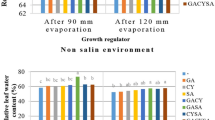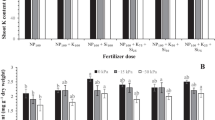Abstract
Winter wheat (Triticum aestivum L. em. Thell. ‘Osage’) was grown in the greenhouse with fertilizer (urea ammonium phosphate, 28-28-0, 200 kg ha−1) placed in strips with the seed at planting or broadcasted before planting and worked into the surface of the soil to determine how severe osmotic injury is with stripped (banded) compared to broadcasted fertilizer. Control plants grew with no fertilizer. The soil was a Kirkland clay loam (Udertic Paleustoll). In addition to osmotic potential, water potential, stomatal resistance, and height were measured during the experiment. At harvest, vegetative yield and elemental composition of the shoots and roots were- determined.
During the first 20 days after planting, the osmotic potential, as well as the water potential, of plants with fertilizer placed in strips was 2 to 3 bars lower, and the stomatal resistance was 2 to 3 s cm−1 higher, than those of plants grown with the broadcaster fertilizer. Leaves of plants with the stripped fertilizer had 12% more N and 42% more P than leaves of plants grown with the broadcasted fertilizer. Because plants grown with stripped fertilizer had a lower final dry weight, shoots with the stripped fertilizer had — 14% less total N, but + 8% more total P, than shoots grown with the broadcasted fertilizer. The results showed that, 20 days after planting, the osmotic potentials of plants grown with fertilizer placed in strips or broadcasted were the same and that there was an increase in efficiency of fertilizer use with placed P.
Similar content being viewed by others
References
Barber SA (1974) A program for increasing the efficiency of fertilizers. Fertilizer Solutions 18 (2), 24–25
Barber SA (1976) Efficient fertilizer use. In Patterson FL, ed. Agronomic research for food. Am Soc Agronomy Spec Pub 26. Madison, Wisconsin: Am Soc Agronomy, pp. 13–29
Barber SA (1977) Placement of phosphate and potassium for increased efficiency. Fertilizer Solutions 21 (2), 2 pp
Barber SA (1977) Application of phosphate fertilizers: methods, rates and time of application in relation to the phosphate status of soils. In The importance of phosphorus in agriculture. Int Superphosphate Manufacturers' Ass Phosphorus in agriculture No 70. Paris: Int Superphosphate Manufacturers' Ass, pp 109–115
de Wit CT (1953) A physical theory on placement of fertilizers. Versl Landbouwk Onderz No 59.4. Wageningen, Holland: Lab of Phys and Meteorol Agr Univ
Fine LO and Carson PL (1954) Phosphorus needs of small grains on a moderately saline soil. Soil Sci Soc Am Proc 18, 60–63
Fried M, Soper RJ and Broeshart H (1975)15N-labelled single-treatment fertility experiments. Agronomy J 67, 393–396
Gray F and Roozitalab MH (1976) Benchmark and key soils of Oklahoma. Okla Agr Exp Sta Misc Pub 97
Kanemasu ET, Thurtell GW and Tanner CB (1969) Design, calibration and field use of a stomatal diffusion porometer. Plant Physiol 44, 881–885
Lawton K and Davis JF (1960) Influence of fertilizer analysis and placement on the emergence, growth, and nutrient absorption by wheat seedlings in the greenhouse. Agronomy J 52, 326–328
Nyborg M and Henning AMF (1969) Field experiments with different placements of fertilizers for barley, flax and rapeseed. Can J Soil Sci 49, 79–88
Passioura JB and Wetselaar R (1972) Consequences of banding nitrogen fertilizers in soil. 2. Effects on the growth of wheat roots. Plant Soil 36, 461–473
Steel RGD and Torrie JH (1960) Principles and procedures of statistics. New York: McGraw-Hill
United States Salinity Laboratory Staff (1954) Saline and alkali soils. Agr Handbook No 60. Washington, D.C.: U S Dept Agr
van Wijk WR (1966) Introduction, the physical method. In van Wijk WR, ed. Physics of plant environment, 2nd edn. Amsterdam: North-Holland Publ. Co, pp 1–16
Author information
Authors and Affiliations
Additional information
Contribution of the Department of Agronomy, Evapotranspiration Laboratory, Kansas Agric. Expt. Sta., Manhattan, KS 66506, U.S.A.
Reprint requests should be sent to the junior author.
Rights and permissions
About this article
Cite this article
Pearson, C.H., Kirkham, M.B. Osmotic potential of wheat grown with fertilizer placed in strips or broadcasted. Fertilizer Research 1, 227–234 (1980). https://doi.org/10.1007/BF01074195
Issue Date:
DOI: https://doi.org/10.1007/BF01074195




